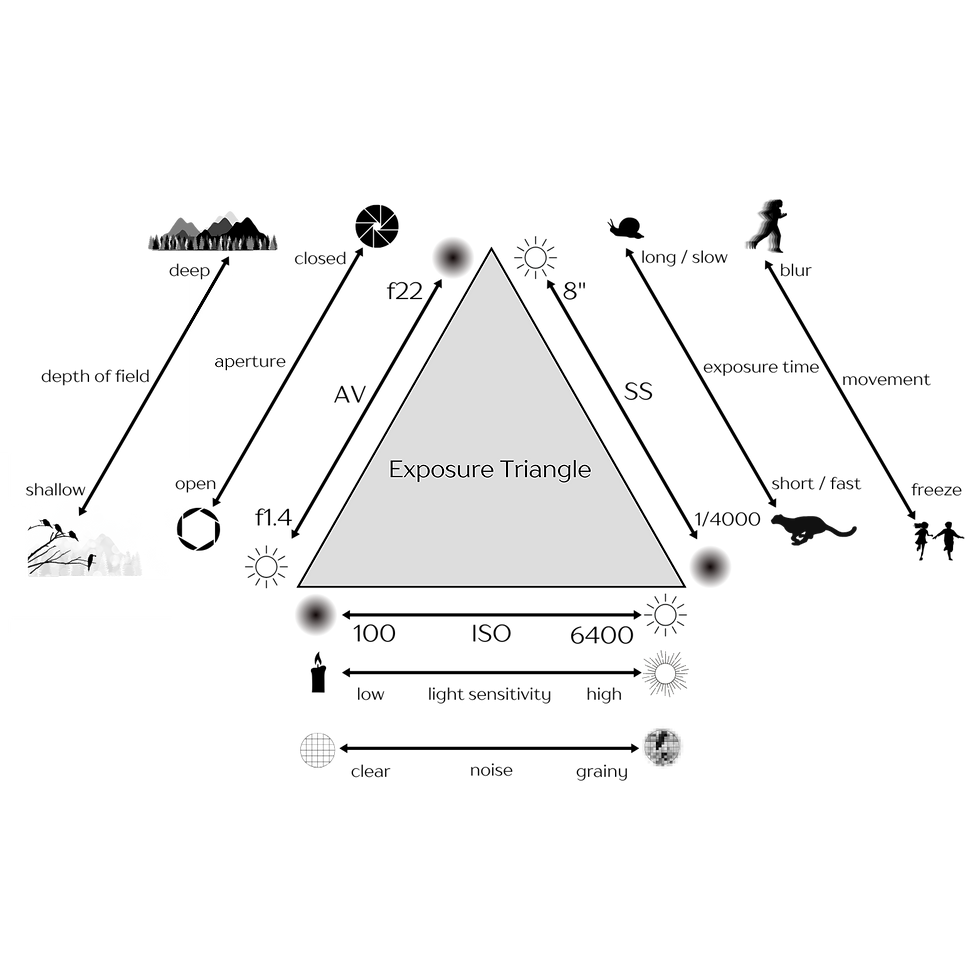The Exposure Triangle
- mhpchans
- Jan 7
- 4 min read
The exposure triangle is the standard for understanding photography. Even if one cannot explain it, even if one is a self-taught photographer, understanding the triangle is the foundation.
At first glance the exposure triangle is information overload, and balancing each of the elements can prove challenging. To truly grasp what the information is conveying, one must use a camera in a trial-and-error sort of way while reviewing the information.
First and most importantly, it is key to understand that everything about a camera, everything about photography, everything about image making is about light. Absolutely everything is about light. Every adjustment and every change, impacts the light. Focal points and amount of detail, rely on light. Every idea and every vision, require light. Therefore, everything about a camera is about working with light. Light must be used intentionally, and so it must be known well. Photography literally means “drawing with light”, so if one does not understand how to use a camera in order to make the light work for the vision, one cannot draw with light. One cannot utilize photography to convey thoughts, opinions, emotions, or stories.
Photography is a form of art. Art is a creative form of expression, subjective, and personal. But art, in any form, cannot be only creativity. To effectively express imagination, innovation, and originality, one must possess and apply a skill, talent, or ability. Which is where the balance for creativity comes into play, the technical.
This is not to imply that an artist of any kind must be educated, trained, or carry proof of technical skill. It is simply a fact that creativity and technicality work together for a greater effect. If someone paints, they have to understand color theory. If someone designs architecture, they have to understand geometry. If someone photographs, they have to understand light.
Diving in.
Have a look at the infographic, familiarize yourself with the terms and consider the graphics.

Now, let’s break it up into manageable bits of information.
Av (or A, AP) is the Aperture Value and is shown with an f/stop number.
The aperture is the opening in the lens that allows light to enter and reach the sensor. The size of this opening is adjusted by changing the f/stop number, which is the aperture setting.
f/1.4 is a low/large aperture, the lens is wide open, allowing in as much light as possible
f/22 is a high/small aperture, the lens has a small opening, allowing in the least amount of light possible.
ISO is the sensitivity to light and is given as a number.
A higher number means higher sensitivity, a greater ability to capture light.
Increasing the number will progressively brighten a photo.
A lower number means lower sensitivity, a lesser ability to capture light.
Decreasing the number will progressively darken a photo.
SS is the Shutter Speed, the speed at which the shutter closes, it is shown in seconds or fractions of seconds.
It determines how long the sensor is exposed to light
Faster shutter speeds allow less light into the sensor, a short exposure
Slower shutter speeds allow more light into the sensor, a long exposure
Increasing or decreasing any one of the three elements will affect the others. These three elements come together and create what is referred to as, the photo’s exposure.
Now this is where things get interesting, because as we know, a camera does do more than just capture or block light.
Each side of the triangle offers a unique way to adjust light, and each side of the triangle offers a variable.
Let’s delve into those.
Aperture, the variable is Depth of Field
A shallow depth of field, at a low f-stop, open lens, creates a sharp, small focal point and soft background blur
A deep depth of field, at a high f-stop, closed lens, creates layers of focal points
ISO, the variable is Noise
A high ISO will introduce noise, creating a grainy look
A low ISO will produce a sharp, clean look
Shutter Speed, the variable is Movement
A fast shutter speed will freeze movement
A slow shutter speed will blur movement
This is a good place to interject that there is much more to image making on the technical side; white balance, dynamic range, focal length, metering, file type, aspect ratio, chromatic aberration, exposure compensation, etc. But, if you do not grasp the exposure triangle, you cannot develop a deeper understanding of these technicalities.
There is no right or wrong in art. What one deems a perfect portrait, another may consider too dark. What one deems a creative style, another may consider poorly executed. But no matter what you are doing, it is absolutely necessary that you understand light. And the best way to understand something is to learn about it and then spend time with it.
Review the information offered in the infographics, familiarize yourself with your camera manual, and then take pictures. Hundreds of them, with a variety of subjects, in every environment, at every time of day, use natural and artificial light, and have fun.
-Elesha Lake
Visual Examples
